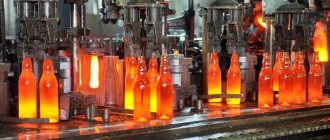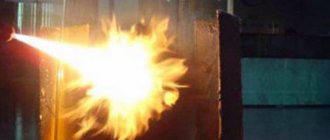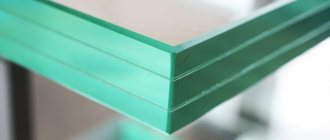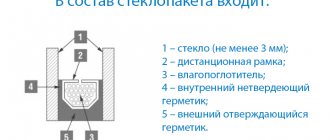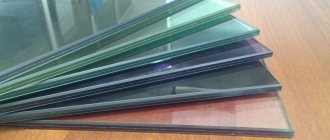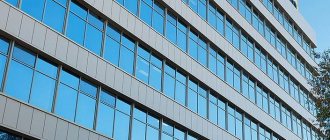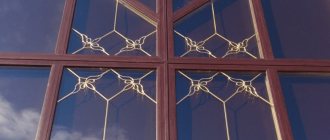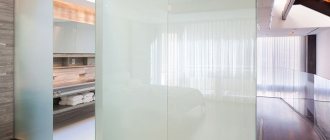Glass is considered to be a fragile material, but there are glasses with increased strength. Protection from robbers and hooligans can be ensured using tempered glass or triplex glass.
They are made using different technologies, and they also react differently to a strong blow; the protective qualities of triplex are higher. This glass can be used in double-glazed windows, in facade glazing, shop windows and entrances, in the manufacture of walls and partitions, furniture and even floors and stairs.
Content
- 1. Differences between triplex and tempered glass
- 2. How triplex and tempered glass are made. Key features of materials 2.1. Strained glass
- 2.2. Triplex
- 3.1. Durability and safety
Why can you be confident in the safety of triplex doors?
Requirements for laminated glass are established by GOST 30826-2014. The technological process of triplex production includes step-by-step quality control, including the use of special instruments. The finished material undergoes a series of tests, during which it is checked for its ability to withstand mechanical and thermal shocks, transmit light, be resistant to moisture, etc.
Such a strict approach is explained by the need to protect human life and health and ensure the safety of material assets. The state standard regulates the properties of all types of laminated glass that are used for installation in translucent building structures with enhanced performance properties, including door and window units, retail display cases, and the like.
How triplex and tempered glass are made. Key features of materials
Tempered glass and triplex are made using different technologies.
Strained glass
Tempered glass is made from ordinary sheets. They are placed in an oven and heated to a temperature of 650–680 °C. After this, the sheets are cooled evenly and quickly with air on both sides. Sudden temperature changes lead to mechanical compressive stress. As a result, the sheets acquire increased strength and heat resistance.
The main features of tempered glass are:
- perfectly smooth sheet edges;
- excellent light transmission;
- possibility of decoration (ceramic printing and sandblasting designs are used).
Note! Drilling holes and other types of mechanical processing are carried out before hardening. If this is done later, the material will collapse.
Photo #1: Tempered glass
Triplex
Triplex glass is made using the technology of gluing several sheets. Moreover, they can be either raw or hardened. When using the latter, technical and operational characteristics are increased to the maximum level.
Image No. 1: triplex structure
Specifically, triplex is made by gluing two sheets together. Polyvinyl butyral film or polyvinyl butyral composition is used for connection. Technologies are different.
- In the first case, polyvinyl butyral film is placed between the sheets and sent to the press. The glasses are then placed in the oven. There, at a temperature of 150 °C, the film melts and reliably glues the sheets together.
- In the second case, the surfaces to be joined are treated with a polyvinyl butyral compound and applied to each other. Bonding occurs under the influence of ultraviolet radiation. The composition polymerizes and reliably holds the glass together.
Let us list the main features of triplex.
- During production, various materials can be laid between the glasses (fabric, lace mesh, colored film, etc.). Triplex is ideal for decoration.
- There are production technologies that produce material with variable transparency.
- Triplex can be processed mechanically after production.
The only negative is the uneven edges. To eliminate this drawback, polishing is used.
Photo No. 2: triplex
As you can see, triplex from tempered glass is easy to distinguish visually.
Varieties
Today, two types of similar products are produced: film and cast.
Film triplex
It consists of several layers of glass, between which there is a connecting adhesive film. To apply it, an autoclave method is used, for which polyvinyl butyral film is used. But this material has the following disadvantages:
- Limited number of layers, and therefore thickness.
- Limited colors.
- Increased chance of product destruction as a result of exposure to high temperatures.
Today there is a non-autoclave production method, when the material is placed in a vacuum chamber. This allows you to increase the thickness of the finished product and give it the required shade.
Differences between triplex and tempered glass in terms of operational and technical characteristics
Let's compare triplex and tempered glass in terms of strength, safety, heat resistance, sound insulation and light transmittance.
Durability and safety
Tempered glass is 5–6 times stronger than its raw counterparts. With very strong impacts, the hardened sheets break. In this case, crumbs are formed with non-sharp edges that cannot be cut. At the same time, there are about 180 non-hazardous fragments per 1 m2 of glass. This meets safety standards.
Photo #3: Broken tempered glass
The strength of triplex depends on the type of glued sheets. The material, consisting of raw glass, withstands impacts much better than conventional analogues.
When using hardened sheets, the strength increases many times over. Shock-proof and armored double-glazed windows are made from such triplex. Material with a thickness of 13 mm or more is considered bulletproof. A Makarov pistol bullet (9 mm) will not pass through such glass.
At the same time, triplex does not crumble into fragments when damaged. They are securely held using a film or a special composition.
Photo No. 4: damaged triplex
Heat resistance
Good tempered glass can withstand high temperatures better. The sheets do not deform when heated to 300 °C.
Triplex is less resistant to high temperatures. It will withstand heating up to 180 °C. This is due to the fact that when the temperature increases, the interlayer is deformed.
Soundproofing
Triplex is the undisputed leader. If the choice of material is mainly influenced by this characteristic, then you should buy triplex rather than tempered glass. A multi-layer package will guarantee maximum sound insulation.
Light transmittance
Light transmission is higher with simple tempered glass. Triplex transmits sunlight worse due to the presence of an intermediate polyvinyl butyral layer.
Self-production
It is possible to create laminated triplex glass at home. This does not require spending a lot of time and effort, but there are conditions that must be met.
Note!
It is necessary to make a binder component only after the glass has been fully prepared.
To do this, the required amount of substance is calculated on the basis that 1 liter of liquid is required to create a layer 1 mm thick over an area of 1 m2. The process itself, how to make a multi-layer product at home, is as follows:
- First, the sheets of glass need to be cut to the desired uniform size.
- The surfaces of the material should be thoroughly cleaned with chemical reagents, rinsed with water and wiped with napkins. In this case, not even lint should remain.
- Mounting tape is applied over the entire surface, and a slight gap is created in the corners so that air can escape when pouring liquid.
- Next, the protective film is removed from the installed mounting foam, except for the future location of the watering can, where the edges extend beyond the glass.
- The next sheet of glass is placed on top and carefully pressed against the previous one along the perimeter.
- Using a thin spout, a watering can is inserted into the designated area, where the protective film is removed.
- A wooden block is placed on the work surface, on which the glass should be placed at an angle. Using a watering can, a liquid adhesive component is poured into the cavity. It is important to avoid interruptions to prevent the formation of air bubbles.
- Upon completion of filling, all corners are sealed with plastic, which will prevent the solution from leaking out, and the watering can is also removed and the last hole is sealed.
- Further along the entire perimeter, the top glass must be pressed, especially in the corners. It is important that the products are on a horizontal surface so that the solution is evenly distributed throughout the internal space. So it is left until it hardens completely.
- The process is repeated until the required number of layers are created.
Triplex is a multilayer glass with increased strength. There are several types of such products, differing in the type of component binder layer. But its negative side is the high cost and difficulty of maintenance.
Areas of application of tempered glass and triplex
Tempered glass is best suited for use in domestic or standard environments. Shower cabins, office partitions, stairs, windows, interior items, etc. are made from hardened sheets.
The main area of application of triplex is industry. This material is used to make glass for cars, trains, airplanes and equipment for special services. In these cases, the use of multi-layer impact-resistant double-glazed windows is completely justified.
Another specialized area of application of triplex is the production of bulletproof windows, partitions, doors, etc. The installation of such structures is relevant for facilities with increased security requirements.
Triplex is also used in everyday life and under standard conditions, but much less frequently. If there is free money, no one forbids spending it on making more beautiful and durable products.
Moskvich 402
The Soviet first-born in the field of curved glass is Moskvich-402.
It came off the assembly line about six months earlier than the Volga GAZ-21, which also had curved glass. The Soviet first-born in the field of curved glass is Moskvich-402. It came off the assembly line about six months earlier than the Volga GAZ-21, which also had curved glass.
The area of the windshield gradually increased: due to a greater slope, an increase in the bending amplitude and height. The designers improved visibility in this way, which contributed to increased safety. All this led to the appearance of the so-called panoramic glass, whose sides were strongly curved. The innovator was again Cadillac with the 1953 Eldorado model.
The end of the 1950s was marked by many experiments with “panoramas”. During these same years, various tinting options and the first athermal glass appeared. And some people have already tried to “bend” the glass, taking a little of the roof - this created for the driver and passengers the illusion of increased freedom and space, and at the same time made it possible to see traffic lights better.
What determines the cost of doors with glass?
For interior glass doors, the price is determined taking into account the type of materials used and their quality. The thickness of the glass used and the type of adhesive element matter. One of the most economical options is transparent flat triplex silicate glass, made using adhesive film.
Artistic processing, the use of decorative elements, and bending require additional production costs, which is reflected in the cost. To avoid additional trade markups, it is better to make purchases online, but always from responsible sellers. Ideally, if the products are sold directly by the manufacturer, since in this case the price will be minimized.
Advantages of using triplex doors
The high aesthetics of triplex allows it to be used in luxurious interiors, in combination with expensive furniture and appliances. Budget options are available to all buyers with good taste.
If the interior doors are not usually glass, but triplex, they can be safely installed in the children's room. The child will be able to freely play with the ball, hitting it against the doors and without causing any harm to them. If a triplex is struck with a strong directed blow with a hammer, you will not have to collect the sharp fragments scattered throughout all the rooms. They will remain on the adhesive material.
Changes in temperature and humidity will not affect the properties of triplex and will not lead to premature wear, so this is an excellent option for use in a bathroom or sauna. Glass surfaces are not difficult to clean from grease, stains of tea, coffee, and juices, so they serve to differentiate the kitchen and living areas.
Having increased soundproofing capabilities, interior doors with triplex glass will provide reliable protection against the penetration of extraneous sounds into the personal space of the bedroom.
Thanks to the strength of the materials and the ability to withstand significant static and dynamic loads, the door structure with triplex demonstrates high reliability and long service life even under conditions of daily intensive use.

